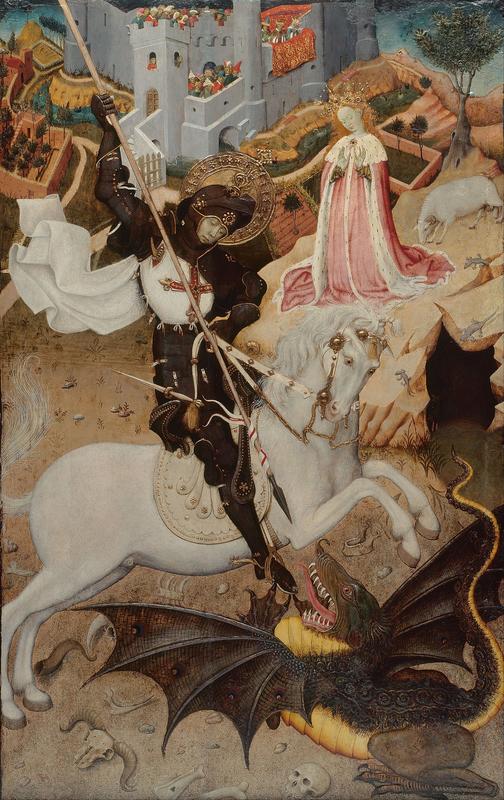More about Saint George Killing the Dragon

Sr. Contributor
Saint George Killing the Dragon, as illustrated by Bernat Martorell, is one of the most iconic legends and visual motifs of Western Christian culture, despite not having originated in the West and having almost nothing to do with Christian theology.
There are countless versions of the popular story, but one of the most common reads less like something you’d hear in Sunday school and more like some bizarre mashup of The Hunger Games, King Kong, and Game of Thrones.
In third-century Libya, the kingdom of Silene is terrorized by a poison-spitting, lake-dwelling dragon. Attempts to appease the monster by sacrificing sheep and then men fail, so the citizens resort to a lottery system by which children and youths are chosen at random for sacrifice. Unfortunately, the odds are not ever in the favor of the princess, who wins this grim lottery one day. The king tries to bribe her way out of it, but after watching their own kids become dragon snacks, the commoners are evidently in no mood. The princess is thus arrayed in a magnificent wedding garment and sent outside the city walls for dragon happy hour. As luck would have it, Saint George just happens to be riding past, and is not one to let a hottie go to waste. He wounds and subdues the beast, but offers to kill it only if the kingdom converts to Christianity. This seems preferable to becoming a dragon buffet, so the people acquiesce and are baptized.
This tale is taken from the 13th-century Golden Legend, written 1,000 years after George supposedly lived, which popularized the narrative in Western Europe. This is the version Martorell likely knew, and all the familiar elements are present: sheep and human bones littering the ground, the princess in her bridal finery, George on his noble steed, and the riveted royal court and populace watching from the city walls. Christian knights adopted the story during the crusades from an older, Eastern tradition originating in Georgia with the action set in Turkey. The slaying of the dragon was initially attributed to Saint Theodore of Amasea, and the narrative itself has roots in earlier pagan mythology such as Perseus and Andromeda and pre-Christian folklore in West Asia. Nonetheless, Saint George became the patron saint of numerous European countries and regions, most notably England and Catalonia, in which Martorell lived and worked.
The odyssey and attribution of this painting is a saga almost as strange as the legend itself. Martorell painted this between 1434 and ‘35 as the central panel of an altarpiece destined for the Catalan governmental palace in Barcelona. The original altarpiece had two smaller panels on either side depicting scenes of the Saint’s life and martyrdom, with a panel of the Virgin and Child on top, perhaps crowned by a lost image of Christ on the Cross.
The altarpiece appeared in the inventory of the palace as late as 1499, but subsequently disappeared in a war or political upheaval. It was missing for over three and a half centuries until it popped up, still intact, in the collection of the Baron of Albi in 1867, when it was apparently broken up in the process of dividing his estate. The side panels are now in the Louvre, whereas the existing top panel is in the Philadelphia Museum of Art. The artist was long unidentified until restorers detected tiny fragments of Catalan newspaper mixed in with the tempera under the dragon’s wings, definitively linking the painting to Martorell.
Sources
- Art Institute Chicago. “Saint George and the Dragon.” Accessed July 21, 2020. https://www.artic.edu/artworks/15468/saint-george-and-the-dragon
- Ashliman, D.L. “The Legend of Saint George.” Abstracted from The Golden Legend; or, Lives of the Saints. Last modified December 16, 2002. https://www.pitt.edu/~dash/stgeorge1.html
- Blanch, Santiago Alcolea. “Extract: Martorell, Bernat [Master of St George; Master of S Jordi; Master of S Jorge].” Oxford Art Online. Accessed July 21, 2020. https://www.oxfordartonline.com/groveart/view/10.1093/gao/9781884446054…
- Collins, Michael H. “St George and the Dragon: The Golden Legend.” Collins.com. Accessed July 21, 2020. http://collinsm.com/the-golden-legend/
- Panini, Franco Cosimo, ed. “Saint George and the Dragon: the origins of the legend.” Folia Magazine, April 21, 2016. https://www.foliamagazine.it/en/saint-george-dragon/
- Renom, Pere. “Saint George and the Dragon: From myth to zoology.” Métode, May 21, 2014. https://metode.org/issues/article-revistes/saint-george-and-the-dragon…
- Whately, E. Gordon, Thompson, Anne B., and Upchurch, Robert K. eds. “St. George and the Dragon: Introduction.” In Saints’ Lives in Middle English Collections (Kalamazoo: Medieval Institute Publications, 2004). https://d.lib.rochester.edu/teams/text/whatle
Featured Content
Here is what Wikipedia says about Saint George and the Dragon (Martorell)
Saint George and the Dragon, also known as Saint George Killing the Dragon is a tempera painting by the Catalan artist Bernat Martorell, painted c. 1434 – c. 1435. It depicts the famous legend of Saint George and the Dragon, in which the Christian knight Saint George rescues a princess from a dragon.
Check out the full Wikipedia article about Saint George and the Dragon (Martorell)












